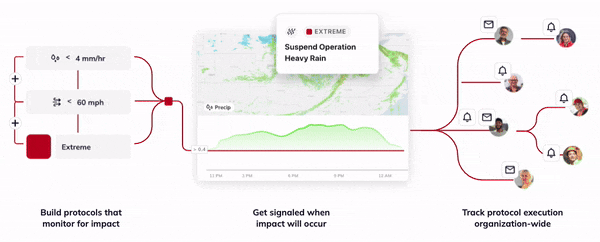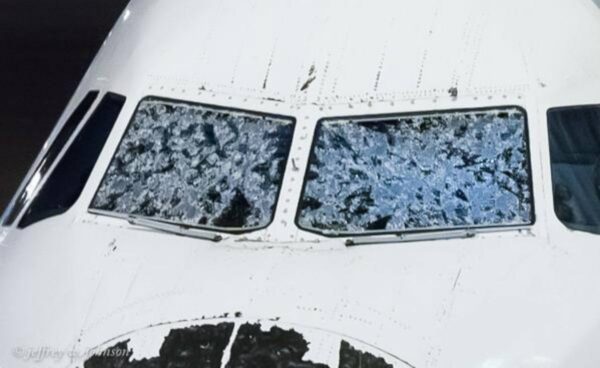TL;DR:
- Hail poses significant operational challenges for airlines, leading to costly repairs and safety risks.
- Advanced hail prediction and detection technologies are crucial for enhancing safety and reducing costs in the aviation sector.
- Modern detection systems and onboard sensors help airlines accurately forecast and detect hail, enabling proactive decision-making.
- Integration of hail forecasts into flight planning systems reduces operational disruptions and improves safety and efficiency.
- Investing in predictive weather technologies can lead to substantial cost savings and operational benefits for airlines.
Hail is an unpredictable weather phenomenon that presents one of the most significant operational challenges. This icy adversary can cause extensive damage to aircraft, leading to costly repairs, delays, and heightened safety risks.
As the aviation sector continually seeks ways to enhance safety and reduce costs, integrating advanced hail prediction and detection technologies has become paramount for every airline.
The advantages are clear and impactful. From improving flight safety by accurately forecasting and detecting hail to optimizing operational efficiency and reducing financial liabilities, airlines can embrace these advancements and safeguard their fleets and passengers while also achieving considerable operational cost savings.
The Threat of Hail to Aviation
Historical Impact of Hail
Hail poses a formidable threat to aircraft, with a history of causing significant operational disruptions and physical damage. Over the years, incidents have ranged from minor cosmetic damage to severe impacts on aircraft structural integrity.
For example, hail can shatter cockpit windshields, dent fuselages, and damage critical sensors, leading to emergency landings and unscheduled maintenance. These events not only result in direct repair costs but also in operational delays and cancellations, which can affect hundreds of flights and thousands of passengers.
Financial and Safety Implications
The financial ramifications of hail damage are substantial. Repairing hail damage can cost airlines anywhere from thousands to millions of dollars per aircraft, depending on the severity.
Moreover, indirect costs include increased insurance premiums, compensation for delayed passengers, and potential revenue loss from out-of-service aircraft. From a safety perspective, hail can impair pilot visibility and aircraft performance, increasing the risk of accidents during critical flight phases, such as takeoff and landing.
How Does Hail Impact Small Aircraft?
Hail damage on small aircraft is a common concern among pilots and aircraft owners.
In a recent r/flying Reddit thread, users shared their insights and experiences about the potential effects of hail damage on a Cessna 182.
Let’s look at the key points raised in the discussion.
- Performance Implications
- While most users suggested that hail damage is primarily cosmetic, some noted that it could slightly increase aerodynamic instability and affect the boundary layer flow across the wing. However, given the slow speed and stable design of the Cessna 182, the impact on performance is likely to be minimal.
- Repair Options and Costs
- Reskinning the wings or replacing them with salvaged ones were mentioned as potential repair options, but both were considered expensive relative to the aircraft’s value. Some users suggested filling the dents with Bondo or lightweight epoxy filler for cosmetic purposes. However, the cost-effectiveness of repairs should be carefully considered.
- Safety Concerns and Inspections
- Several comments highlighted the importance of assessing any underlying structural damage, particularly to the wing spars and ribs. Before flying an aircraft with hail damage, it is crucial to have a thorough inspection conducted by a qualified mechanic to ensure its structural integrity and safety.
- Insurance Coverage
- Insurance coverage for hail damage depends on the policy in place at the time of the incident. If the damage was covered, it would likely have been repaired already. Aircraft owners should review their insurance policies to understand their coverage for such incidents.
- Resale Value Considerations
- Hail damage can significantly reduce an aircraft’s resale value, with estimates ranging from a 30-50% reduction. For potential buyers, purchasing a hail-damaged aircraft at a discounted price and repairing it might be a viable option, provided the damage is not too severe.
While hail damage on small aircraft like the Cessna 182 may not significantly affect performance, it is essential to consider the potential impact on structural integrity, safety, and resale value.
A thorough inspection and a careful assessment of repair costs are necessary before deciding to purchase or fly a hail-damaged aircraft.
And if that’s the impact of hail on a small aircraft, you can imagine it would be even larger for larger airline planes.
Advances in Hail Detection Technology
State-of-the-Art Detection Systems
Modern hail detection systems utilize an array of technologies, including radar and satellite data, to monitor weather conditions in real-time. Ground-based radar systems are particularly effective at detecting hail-producing storms by analyzing the shape and behavior of precipitation particles within clouds.
Additionally, satellite imagery provides a broader view, identifying potential hail events before they impact operations. These technologies collectively enable airlines to receive timely warnings about hail, allowing them to reroute flights or delay departures to ensure safety.
Role of Onboard Sensors
Onboard sensors are crucial in detecting hail and other adverse weather conditions directly from the aircraft. These sensors, integrated with the aircraft’s avionics systems, provide pilots with real-time data about atmospheric conditions. This includes information on cloud density, precipitation type, and storm intensity, which is vital for making informed decisions during flight. By having access to immediate and accurate weather updates, pilots can navigate around hazardous areas, minimizing the risk of hail damage.
Hail Prediction and Weather Forecasting Integration
Predictive Analytics in Weather Forecasting
Hail prediction has advanced significantly with the integration of predictive analytics into weather forecasting. These systems use historical weather data combined with real-time observations to model and predict the likelihood of hail formation. Algorithms analyze factors such as atmospheric instability, humidity levels, and wind shear to forecast not just the possibility of hail but also its potential size and trajectory. This predictive capability is essential for proactive planning and operational adjustments in aviation.

Tomorrow.io’s Resilience Platform allows you to build protocols and get insights as they relate to weather impact.
Integration with Flight Planning Systems
The integration of hail forecasts into flight planning systems represents a significant step forward in operational safety and efficiency. These advanced systems allow airline operation centers to adjust flight routes in advance, avoiding areas with predicted hail activity. By incorporating weather forecasting directly into the flight planning process, airlines can optimize routes for safety and fuel efficiency, reducing the likelihood of encountering hail and other severe weather conditions during flights.
Reducing Operational Disruptions
Implementing hail avoidance strategies based on advanced detection and prediction technologies significantly reduces the frequency and severity of operational disruptions. By rerouting flights in response to real-time and predictive hail information, airlines can avoid the zones most likely to experience hail, thereby decreasing the chances of aircraft damage and the consequent delays and cancellations. This proactive approach not only ensures passenger safety but also helps maintain the airline’s schedule integrity, which is crucial for customer satisfaction and operational profitability.
Long-term Cost Benefits
The long-term financial benefits of effective hail management are substantial. By minimizing the incidence of hail damage, airlines can reduce the costs associated with repairs and maintenance, potentially saving significant amounts of money. Additionally, better risk management translates to more favorable insurance premiums as insurers recognize the reduced risk profile of operations. Furthermore, maintaining a reputation for reliability and safety in adverse weather conditions enhances brand value and customer loyalty, contributing to sustained revenue growth.
Case Studies
Major Airlines – Advanced Weather Tracking and Predictive Analytics
In 2019, a major airline in the US faced forecasts of severe hail and thunderstorms across the Midwest. Utilizing its advanced weather tracking and predictive analytics system, Delta proactively adjusted flight schedules and routes, avoiding the predicted severe weather.
This strategy led to a reduction in weather-related delays by approximately 25%, translating to estimated savings of up to $3 million in operational costs for that event alone. This use case demonstrates the tangible business value of investing in predictive weather technologies, not only in safeguarding assets but also in enhancing overall operational efficiency.
JetBlue Airlines – Collaborative Decision Making with Weather Services
During a severe weather forecast in August 2021 in the Northeastern United States, United Airlines collaborated with weather forecasting services to reroute flights and adjust schedules proactively. This initiative prevented potential hail damage and avoided significant disruptions, resulting in a 20% reduction in weather-related cancellations and delays compared to similar events in previous years. The proactive measures not only protected the airline’s fleet but also saved approximately $2 million in potential delay and cancellation costs, showcasing the critical role of real-time weather data in strategic operational planning.
Lessons Learned
The experiences of these airlines with regard to hail prediction data demonstrates key lessons in weather risk management:
- Investment in Technology: Continuous investment in the latest weather prediction technologies pays dividends in operational safety and cost efficiency.
- Integrated Operations: Seamless integration of weather monitoring systems with flight planning and operations is critical for maximizing the benefits of weather technology.
- Staff Training: Educating pilots and operational staff on the capabilities and use of weather prediction tools is essential for leveraging these technologies effectively.
Looking Forward With Tomorrow.io’s Resilience Platform
Airlines seeking to enhance their weather risk management can start by assessing their current technological capabilities and eny6 gaging with experts in weather technology, like those at Tomorrow.io.
By adopting Tomorrow.io’s advanced weather solutions, airlines can journey towards more optimized operations and improved safety, leveraging cutting-edge systems tailored to their needs. This commitment to advanced weather technology is crucial for airlines aiming to elevate their operational efficiency and safety standard.





